 设计模式 - 结构型组合模式
设计模式 - 结构型组合模式
# 组合模式基本介绍
在现实生活中,存在很多「部分-整体」的关系,例如,大学中的部门与学院、总公司中的部门与分公司、学习用品中的书与书包、生活用品中的衣服与衣柜、以及厨房中的锅碗瓢盆等。在软件开发中也是这样,例如,文件系统中的文件与文件夹、窗体程序中的简单控件与容器控件等。对这些简单对象与复合对象的处理,如果用组合模式来实现会很方便。
组合模式(Composite Pattern),又叫 部分整体模式,它创建了对象组的树形结构,将对象组合成树状结构以表示「整体-部分」的层次关系,属于结构型模式。
组合模式依据树形结构来组合对象,用来表示部分以及整体层次。
组合模式使得用户对单个对象和组合对象的访问具有一致性,即:组合能让客户以一致的方式处理个别对象以及组合对象。
主要优点
- 组合模式使得客户端代码可以一致地处理单个对象和组合对象,无须关心自己处理的是单个对象,还是组合对象,这简化了客户端代码
- 更容易在组合体内加入新的对象,客户端不会因为加入了新的对象而更改源代码,满足「开闭原则」
主要缺点
- 设计较复杂,客户端需要花更多时间理清类之间的层次关系;
- 不容易限制容器中的构件
- 不容易用继承的方法来增加构件的新功能
# 组合模式结构与实现
- 抽象构件(Component)角色:它的主要作用是为树叶构件和树枝构件声明公共接口,并实现它们的默认行为。在透明式的组合模式中抽象构件还声明访问和管理子类的接口;在安全式的组合模式中不声明访问和管理子类的接口,管理工作由树枝构件完成。(总的抽象类或接口,定义一些通用的方法,比如新增、删除)
- 树叶构件(Leaf)角色:是组合中的叶节点对象,它没有子节点,用于继承或实现抽象构件
- 树枝构件(Composite)角色 / 中间构件:是组合中的分支节点对象,它有子节点,用于继承和实现抽象构件。它的主要作用是存储和管理子部件,通常包含 Add()、Remove()、GetChild() 等方法
组合模式分为透明式的组合模式和安全式的组合模式。
# 透明方式
在该方式中,由于抽象构件声明了所有子类中的全部方法,所以客户端无须区别树叶对象和树枝对象,对客户端来说是透明的。但其缺点是:树叶构件本来没有 Add()、Remove() 及 GetChild() 方法,却要实现它们(空实现或抛异常),这样会带来一些安全性问题。其结构图如图所示。
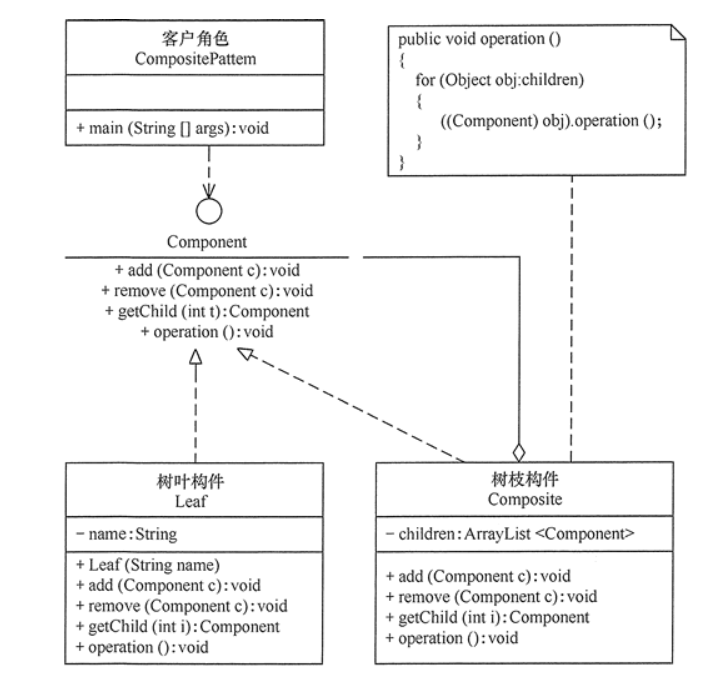
# 安全方式
在该方式中,将管理子构件的方法移到树枝构件中,抽象构件和树叶构件没有对子对象的管理方法,这样就避免了上一种方式的安全性问题,但由于叶子和分支有不同的接口,客户端在调用时要知道树叶对象和树枝对象的存在,所以失去了透明性。其结构图如图所示。
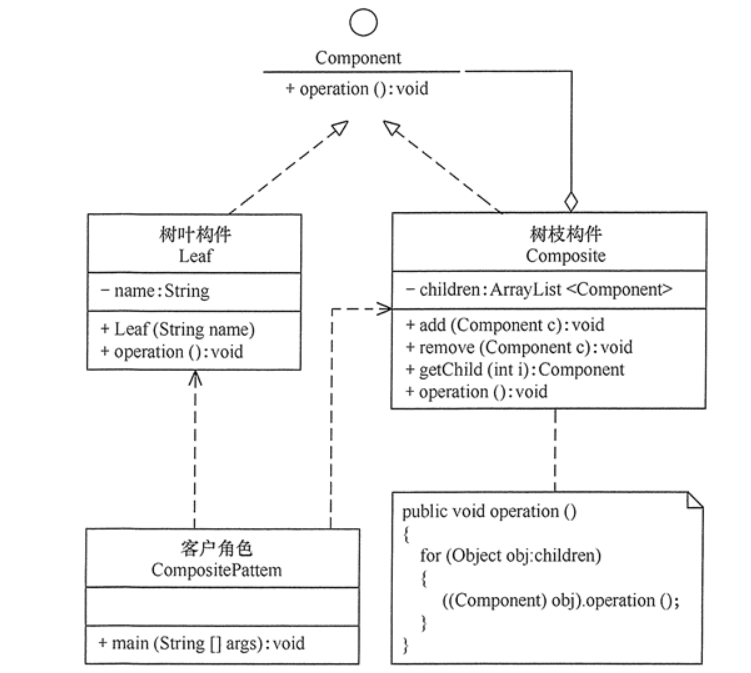
# 模式的实现
假如要访问集合 c0={leaf1,{leaf2,leaf3}} 中的元素,其对应的树状图如图所示。
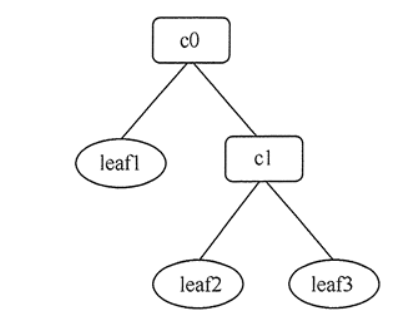
下面为透明式的组合模式的实现代码
// 抽象构件
interface Component {
public void add(Component c);
public void remove(Component c);
public Component getChild(int i);
public void operation();
}
// 树叶构件
class Leaf implements Component {
private String name;
public Leaf(String name) {
this.name = name;
}
public void add(Component c) {
}
public void remove(Component c) {
}
public Component getChild(int i) {
return null;
}
public void operation() {
System.out.println("树叶" + name + ":被访问!");
}
}
// 树枝构件
class Composite implements Component {
private ArrayList<Component> children = new ArrayList<Component>();
public void add(Component c) {
children.add(c);
}
public void remove(Component c) {
children.remove(c);
}
public Component getChild(int i) {
return children.get(i);
}
public void operation() {
for (Object obj : children) {
((Component) obj).operation();
}
}
}
public class CompositePattern {
public static void main(String[] args) {
Component c0 = new Composite();
Component c1 = new Composite();
Component leaf1 = new Leaf("1");
Component leaf2 = new Leaf("2");
Component leaf3 = new Leaf("3");
c0.add(leaf1);
c0.add(c1);
c1.add(leaf2);
c1.add(leaf3);
c0.operation();
}
}
2
3
4
5
6
7
8
9
10
11
12
13
14
15
16
17
18
19
20
21
22
23
24
25
26
27
28
29
30
31
32
33
34
35
36
37
38
39
40
41
42
43
44
45
46
47
48
49
50
51
52
53
54
55
56
下面为安全的组合模式的实现代码
// 抽象构件
interface Component {
public void operation();
}
// 树叶构件
class Leaf implements Component {
private String name;
public Leaf(String name) {
this.name = name;
}
public void add(Component c) {
}
public void remove(Component c) {
}
public Component getChild(int i) {
return null;
}
public void operation() {
System.out.println("树叶" + name + ":被访问!");
}
}
// 树枝构件
class Composite implements Component {
private ArrayList<Component> children = new ArrayList<Component>();
public void add(Component c) {
children.add(c);
}
public void remove(Component c) {
children.remove(c);
}
public Component getChild(int i) {
return children.get(i);
}
public void operation() {
for (Object obj : children) {
((Component) obj).operation();
}
}
}
public class CompositePattern {
public static void main(String[] args) {
Composite c0 = new Composite();
Composite c1 = new Composite();
Component leaf1 = new Leaf("1");
Component leaf2 = new Leaf("2");
Component leaf3 = new Leaf("3");
c0.add(leaf1);
c0.add(c1);
c1.add(leaf2);
c1.add(leaf3);
c0.operation();
}
}
2
3
4
5
6
7
8
9
10
11
12
13
14
15
16
17
18
19
20
21
22
23
24
25
26
27
28
29
30
31
32
33
34
35
36
37
38
39
40
41
42
43
44
45
46
47
48
49
50
51
52
53
# 学校院系展示需求
编写程序展示一个学校院系结构:需求是这样,要在一个页面中展示出学校的院系组成,一个学校有多个学院,一个学院有多个系。如图:
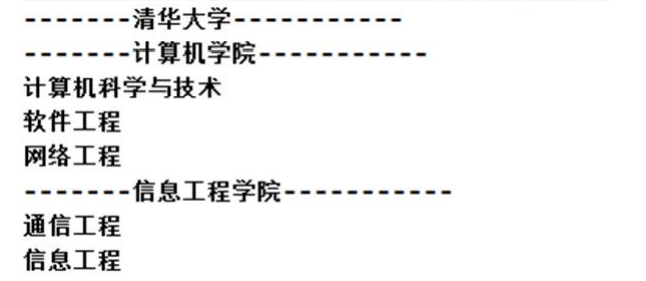
# 传统方案解决学校院系展示
类图:
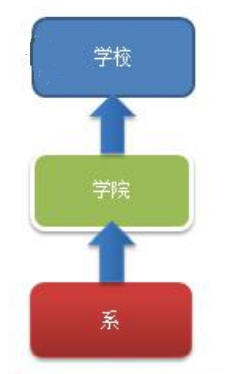
分析:
- 将学院看做是学校的子类,系是学院的子类,这样实际上是站在组织大小来进行分层次的
- 实际上我们的要求是:在一个页面中展示出学校的院系组成,一个学校有多个学院,一个学院有多个系, 因此这种方案,不能很好实现的管理的操作,比如对学院、系的添加,删除,遍历等
- 解决方案:把学校、院、系都看做是组织结构,他们之间没有继承的关系,而是一个树形结构,可以更好的实现管理操作,即使用 组合模式
# 组合模式解决学校院系展示
思路分析和图解(类图)
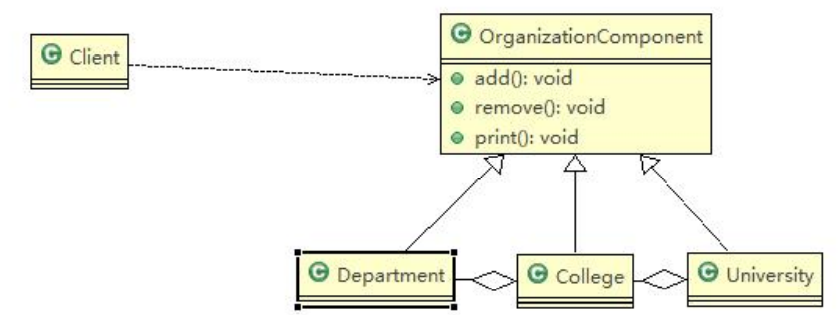
代码示例
公共抽象组件
public abstract class OrganizationComponent {
private String name; // 名字
private String des; // 说明
protected void add(OrganizationComponent organizationComponent) {
// 默认实现
throw new UnsupportedOperationException();
}
protected void remove(OrganizationComponent organizationComponent) {
// 默认实现
throw new UnsupportedOperationException();
}
// 构造器
public OrganizationComponent(String name, String des) {
super();
this.name = name;
this.des = des;
}
public String getName() {
return name;
}
public void setName(String name) {
this.name = name;
}
public String getDes() {
return des;
}
public void setDes(String des) {
this.des = des;
}
// 方法 print,做成抽象的,子类都需要实现
protected abstract void print();
}
2
3
4
5
6
7
8
9
10
11
12
13
14
15
16
17
18
19
20
21
22
23
24
25
26
27
28
29
30
31
32
33
34
35
36
37
38
39
40
41
大学类
public class University extends OrganizationComponent {
List<OrganizationComponent> organizationComponents = new ArrayList<OrganizationComponent>();
// 构造器
public University(String name, String des) {
super(name, des);
}
// 重写 add
@Override
protected void add(OrganizationComponent organizationComponent) {
organizationComponents.add(organizationComponent);
}
// 重写 remove
@Override
protected void remove(OrganizationComponent organizationComponent) {
organizationComponents.remove(organizationComponent);
}
@Override
public String getName() {
return super.getName();
}
@Override
public String getDes() {
return super.getDes();
}
// print 方法,就是输出 University 包含的学院
@Override
protected void print() {
System.out.println("--------------" + getName() + "--------------");
// 遍历 organizationComponents
for (OrganizationComponent organizationComponent : organizationComponents) {
organizationComponent.print();
}
}
}
2
3
4
5
6
7
8
9
10
11
12
13
14
15
16
17
18
19
20
21
22
23
24
25
26
27
28
29
30
31
32
33
34
35
36
37
38
39
40
41
学院类
public class College extends OrganizationComponent {
// List 中 存放的 Department
List<OrganizationComponent> organizationComponents = new ArrayList<OrganizationComponent>();
// 构造器
public College(String name, String des) {
super(name, des);
}
// 重写 add
@Override
protected void add(OrganizationComponent organizationComponent) {
// 将来实际业务中,Colleage 的 add 和 University add 不一定完全一样
organizationComponents.add(organizationComponent);
}
// 重写remove
@Override
protected void remove(OrganizationComponent organizationComponent) {
organizationComponents.remove(organizationComponent);
}
@Override
public String getName() {
return super.getName();
}
@Override
public String getDes() {
return super.getDes();
}
// print 方法,就是输出 University 包含的学院
@Override
protected void print() {
System.out.println("--------------" + getName() + "--------------");
// 遍历 organizationComponents
for (OrganizationComponent organizationComponent : organizationComponents) {
organizationComponent.print();
}
}
}
2
3
4
5
6
7
8
9
10
11
12
13
14
15
16
17
18
19
20
21
22
23
24
25
26
27
28
29
30
31
32
33
34
35
36
37
38
39
40
41
42
43
专业类
public class Department extends OrganizationComponent {
//没有集合
public Department(String name, String des) {
super(name, des);
}
//add , remove 就不用写了,因为他是叶子节点
@Override
public String getName() {
return super.getName();
}
@Override
public String getDes() {
return super.getDes();
}
@Override
protected void print() {
System.out.println(getName());
}
}
2
3
4
5
6
7
8
9
10
11
12
13
14
15
16
17
18
19
20
21
22
测试代码
public class Client {
public static void main(String[] args) {
//从大到小创建对象 学校
OrganizationComponent university = new University("清华大学", " 中国顶级大学 ");
//创建 学院
OrganizationComponent computerCollege = new College("计算机学院", " 计算机学院 ");
OrganizationComponent infoEngineercollege = new College("信息工程学院", " 信息工程学院 ");
//创建各个学院下面的系(专业)
computerCollege.add(new Department("软件工程", " 软件工程不错 "));
computerCollege.add(new Department("网络工程", " 网络工程不错 "));
computerCollege.add(new Department("计算机科学与技术", " 计算机科学与技术是老牌的专业 "));
//
infoEngineercollege.add(new Department("通信工程", " 通信工程不好学 "));
infoEngineercollege.add(new Department("信息工程", " 信息工程好学 "));
//将学院加入到 学校
university.add(computerCollege);
university.add(infoEngineercollege);
//university.print();
infoEngineercollege.print();
}
}
2
3
4
5
6
7
8
9
10
11
12
13
14
15
16
17
18
19
20
21
22
23
24
25
26
27
28
# JDK 集合的组合模式剖析
Java 的集合类 HashMap 就使用了组合模式。
类图:
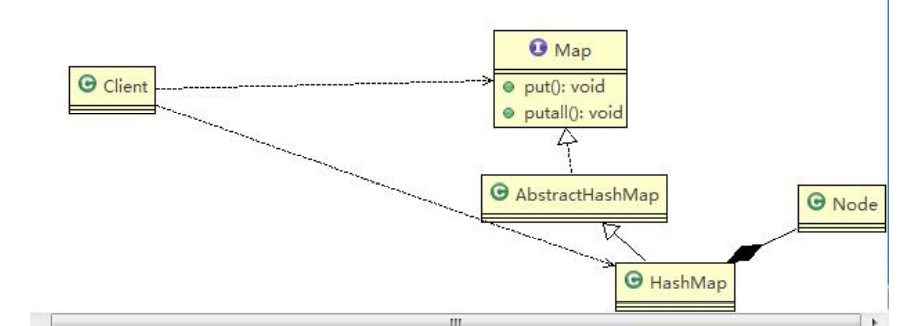
# 组合模式的注意事项和细节
简化客户端操作。客户端只需要面对一致的对象而不用考虑整体部分或者节点叶子的问题。
具有较强的扩展性。当我们要更改组合对象时,我们只需要调整内部的层次关系,客户端不用做出任何改动。
方便创建出复杂的层次结构。客户端不用理会组合里面的组成细节,容易添加节点或者叶子从而创建出复杂的 树形结构。
需要 遍历组织机构,或者处理的对象具有树形结构时, 非常 适合使用组合模式。
要求较高的抽象性,如果 节点和叶子有很多差异性的话,比如很多方法和属性都不一样,不适合使用组合模式。
# 组合模式的应用场景
前面分析了组合模式的结构与特点,下面分析它适用的以下应用场景。
- 在需要表示一个对象整体与部分的层次结构的场合
- 要求对用户隐藏组合对象与单个对象的不同,用户可以用统一的接口使用组合结构中的所有对象的场合
